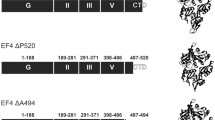Abstract
Some molecular properties of the elongation factor Tu of protein synthesis purified in an aggregated state from gram-positiveStreptomyces aureofaciens were studied and compared with those of Tu from gram-negativeEscherichia coli. Electrofocussing under reducing conditions showed that the molecule of EF-Tu fromS. aureofaciens has an isoelectric point shifted more to the acidic side compared with EF-Tu fromE. coli. A comparison of amino acid composition revealed minor differences in the content of several amino acids in the two factors and showed that EF-Tu fromS. aureofaciens contains four half-cystines per molecule. Under denaturing conditions only two mercapto groups reacted with 5,5’-dithiobis(2-nitrobenzoic acid). Limited tryptic digestion of aggregated EF-Tu fromS. aureofaciens yields six fragments: the four main fragments are of a similar size as those of theE. coli factor. All fragments detected after trypsin digestion ofS. aureofaciens EF-Tu were immunologically cross-reactive with antibodies againstE. coli EF-Tu. However, even after 2 h of the reaction there still remains a small part of streptomycete factor uncleaved, which documents high resistance of aggregated EF-Tu towards trypsin.
Similar content being viewed by others
References
Arai K.I., Clark B.F.C., Duffy L., Jones M.D., Kaziro Y., Laursen R.A., Italien J.L., Miller D.L., Nagarkatti S., Nakamura S., Nielsen K.M., Petersen T.E., Takahashi K., Wade M.: Primary structure of elongation factor Tu fromEscherichia coli.Proc.Nat.Acad.Sci. USA77, 1326–1330 (1980).
Arai K.I., Kawakita M., Nakamura S., Ishikava I., Kaziro Y.: Studies on the polypeptide elongation factor fromE. coli. VI. Characterization of SH groups in EF-Tu and EF-Ts.J.Biochem.76, 523–534 (1974).
Arai K.I., Ota Y., Arai N., Nakamura S., Henecke C., Oshima T., Kaziro Y.: Studies on polypeptide-chain-elongation factors from an extreme thermophileThermus thermophilus HB8. 1. Purification and some properties of the purified factors.Eur.J.Biochem.92, 509–519 (1978).
Beck B.D., Arscott P.G., Jacobson A.: Novel properties of bacterial elongation factor Tu.Proc.Nat.Acad.Sci.USA75, 1250–1254 (1978).
Beck B.D.: Polymerization of the bacterial elongation factor for protein synthesis EF-Tu.Eur. J.Biochem.97, 495–502 (1979).
Blumenthal T., Lenders T.A., Weber K.: Bacteriophage Qβ replicase contains the protein biosynthesis elongation factors EF-Tu and EF-Ts.Proc.Nat.Acad.Sci. USA69, 1313–1317 (1972).
Duisterwinkel F.J., Degraaf J.M., Kraal B., Bosch L.: A kirromycin resistant elongation factor EF-Tu fromEscherichia coli contains a threonine instead of an alanine residue in position 375.FEBS Lett.131, 89–93 (1981).
O farrell P.M.: High resolution two-dimensional electrophoresis of proteins.J.Biol.Chem.250, 4007–4021 (1975).
Filer D., Furano A.: Portions of the gene encoding elongation factor Tu are highly conserved in prokaryotes.J.Biol.Chem.255, 807–812 (1980).
Furano A.V.: Content of elongation factor Tu inEacherichia coli.Proc.Nat.Acad.Sci.USA72, 4780–4784 (1975).
Guijarro J.A., Suarez J.E. Salas J.A., Hardisson C.: Pattern of protein degradation during germination ofStreptomyces antibioticus spores.Can.J.Microbiol.29, 637–643 (1983).
Jacobson G.R., Rosenbusch J.D.: Abundance and membrane association of elongation factor Tu inE. coli. Nature261, 23–26 (1976).
Jonák J., Rychlík I.: Chemical evidence for the involvement of histidyl residues in the functioning ofEscherichia coli elongation factor Tu.FEBS Lett.117, 167–171 (1980).
Kostka V., Cabpenter F.M.: Inhibition of chymotrypsin activity in crystalline trypsin preparations.J.Biol.Chem.239, 1799–1803 (1964).
Laemmli U.K.: Cleavege of structural proteins during the assembly of the head of bacteriophage T4.Nature227, 680–685 (1970).
Lucas-Lenard J., Lipmann F.: Separation of three microbial amino acid polymerization factors.Proc.Nat.Acad.Sci.USA55, 1562–1566 (1965).
Miller D.L., Hachmann J., Weissbach M.: The reactions of the sulfhydryl groups on the elongation factors Tu and Tc.Arch.Biochem.Biophys.144, 115–121 (1971).
Miller D.L., Weissbach H.: Studies on the purification and properties of factor Tu fromE. coli. Arch.Biochem.Biophys.141, 26–37 (1970).
Miller D.L. Weissbach H.: Factors involved in the transfer of aminoacyl-tRNA. to the ribosome, pp. 323–373 in H. Weissbach, S. Pestka (eds.):Molecular Mechanisms of Protein Biosynthesis. Academic Press, New York-London 1977.
Nakamura S., Ohta S., Arai K.I., Arai N., Oshima T., Kaziro Y.: Studies on polypeptide chain elongation factors from an extreme thermophile.Thermus thermophilus HB8. 3. Molecular properties.Eur.J.Biochem.92, 533–543 (1978).
Nakano A., Miyazawa T., Nakamura S., Kaziro Y.: Involvement of histidine residues in the substrate binding of elongation factor Tu fromThermus thermophilus: proton nuclear magnetic resonance and photooxidation study.Arch.Biochem.Biophys.196, 233–238 (1979).
Rosenbusch J.P., Jacobson G.R., Jaton J.C.: Does a bacterial elongation factor share a common evolutionary ancestor with actin?J.Supramol.Struct.5, 391–396 (1976).
Travers A.: Control of ribosomal RNA synthesisin vitro.Nature244, 15–18 (1973).
Weiser J., Mikulík K., Bosch L.: Studies on the elongation factor Tu fromStreptomyces aureofaciens producing tetracycline.Biochem.Biophys.Res.Commun.99, 16–22 (1981).
Weiser J., Mikulík K., Žižka Z., Šťastná J., Janda I., Jiráňová A.: Isolation and characterization ofStreptomyces aureofaciens protein-synthesis elongation factor Tu in an aggregated state.Eur.J.Biochem.129, 127–132 (1982).
Wittinghofer A., Lebermann R.: Elongation factor T fromBacillus stearothermophilus andEscherichia coli. Purification and some properties of EF-Tu and EF-Ts fromBacillus stearothermophilus.Eur.J.Biochem.62, 373–382 (1976).
Wittinghofer A., Leberman R.: A sulfhydryl group is not essential for the binding of GDP to elongation factor Tu.FEBS Lett.101, 153–156 (1979).
Author information
Authors and Affiliations
Additional information
We are indebted to Drs. J. Jonák, J. Pohl and V. Hořejší for helpful advices and discussions and to Dr. K. Mikulík for providing us with TPCK-treated trypsin.
Rights and permissions
About this article
Cite this article
Weiser, J., Šebo, P. Molecular properties of elongation factor Tu fromStreptomyces aureofaciens andEscherichia coli . Folia Microbiol 33, 81–87 (1988). https://doi.org/10.1007/BF02928072
Received:
Issue Date:
DOI: https://doi.org/10.1007/BF02928072




